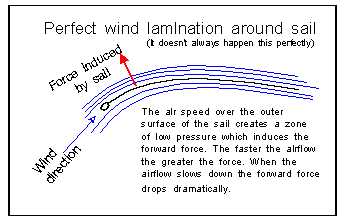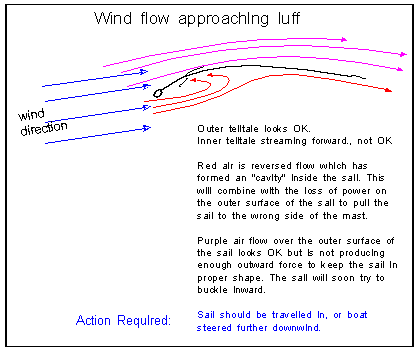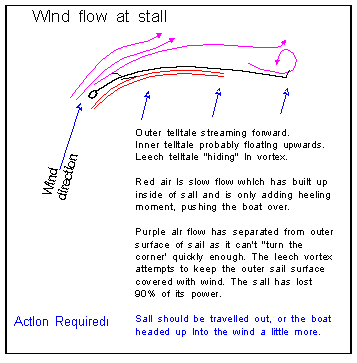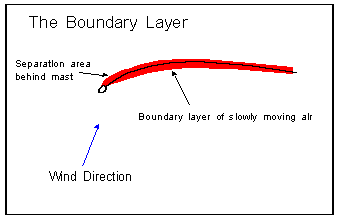Copyright TheBeachcats.com
Please Support
TheBeachcats.com
Telltales do more than just enjoy rolling around in the breeze. They might like rolling around in the breeze on really lazy days, but mostly they prefer streaming out with the wind running across their back. If those other boats are passing you by, take a look at your telltales. They should be the first thing to tell when you are slowing down.
One of the surprising things about telltales is that they are so recent. Your local library probably has many books in its sailing section with no mention of telltales, and they will also be absent from the boats in the photographs. Some sailors put what they called "tufts" on their sails, but they were an obscure minority. However, somewhere in the last twenty years tufts have turned into telltales, and they have crept onto nearly everybody's sails and into most sailing books. Books and magazines I have from about twenty years ago show not a telltale in sight and they include some big name innovators such as Frank Bethwaite and Bob Miller (later known as Ben Lexcen).
Telltales show the actual wind across the sail surface. That sounds simple, and simple is how the telltale likes it. However, the air flown a sail can become complicated, and when it does the telltale will complain to you.

The wind you feel across your back when sailing is not the wind the sail feels. When the wind flows over the sail it has to make some compromises.
1. There is a mast in the way that is not the wind's preferred shape.
2. The sail is very thin, and the wind prefers a thicker section like an airplane wing without a concave lower surface.
3. The angle of the sail to the wind sometimes makes the wind separate from the sail, or makes it build up against it.
4. The sail is highly flexible and the wind prefers to push it into a less powerful shape.
In all these things the air flow will make its own compromises.
The mast means that there is a pocket of turbulence for the first few inches of the sail. Like a "wind shadow". The thin sail means that the wind has to follow a curved inner surface and can develop a thick layer of still or slow air in there. The angle of attack might mean that the wind just can't bend around to the back of the sail quickly enough, and so it leaves a swirling bubble of air on the lee surface which robs the sail of power. Or it might separate from the aft area of the sail and form a whirlwind on the lee side, also robbing the sail of power. When the moving air hits the sail it slows down because of the friction. This layer of "slow" air can be several inches thick, and it can separate the real wind from the sail, again robbing you of power and speed. The wind can push the power producing surface of the sail inwards, causing, you guessed it, loss of power and speed.
The task of the telltale is to tell you what is happening with the airflow against the sail surface, and to allow you to make these compromises between wind and sail as advantageous to you as possible.
Where Should They Be?
Do not put too many telltales on your sails. Although every telltale will tell you something, you can only take effective notice of a certain amount of information at a time. As well as sail telltales, many sailors have some form of telltale on their side stays, masthead, and fore-stay separator.
On the mainsail the best sites for telltales is about twelve inches back from the mast. Place a pair just above the forestay tang so it has clear airflow unaffected by the jib. Place another pair halfway down the sail from the tang, or about the mid-position of the jib.
Another place for telltales is streaming from the leech. Attach them to the batten pockets at battens 2 & 3 (or 4) from the top. You will not see too many small boats with leech telltales, but many larger yachts have them. In a few more years this might be another change to small boat sailing coming from the racing world.
On the jib, place two pairs also. The top pair about one third down from the top, and the lower pair about one third from the bottom. Once again come in from the luff about twelve inches. Some people put two lower pairs on the jib. The number two set is slightly higher than the firsthand only six inches away from the luff. The second set is more sensitive(being closer to the luff) and so is used in light conditions, the lower set (being further from the luff) is less sensitive and is used in heavy conditions.
Your telltales are probably already installed and flying from the same point on the sale for each side. A better idea is to have the starboard telltale attached a couple of inches above the port. This is the same configurations the number on your sail. By having them separated like this you can more easily tell which is which in very bright conditions when the sun makes it difficult to see.
There are two things which the sail might do to slow you down.
Luffing
Luffing is when you try to sail too high into the wind and the wind can no longer hold the sail out like a wing to induce an efficient forward force. The wind becomes undecided which way around the sail it prefers to move and is about to try both directions at once. Too far into a luff and the sail, especially the jib, flaps from one side to another.
The windward (inside) telltales will tell you when you are approaching a luff. When they start to point upwards or forwards you are either pointing too high or your jib is not sheeted in enough. To correct, sail off the wind a little or pull in the jib. A slight luff is not as serious as a stall because the lee side of the sail produces the power. The inner side effects efficient air flow, but do not have the significance of the outer surface of the sail.

Stalling
Stalling is invisible because the sail will still keep its airfoil shape but it won't produce power. A stall is induced when you sail too far off the wind, or have the traveler in too close to the centre on a reach. The sail's angle of attack is too great, and the wind can't stay attached to the lee side of the sail. A pocket of turbulence results on the leeside, there is no real wind/sail contact, and the boat goes ever more slowly.
The leeward (outside) telltales will tell you when you are stalling. If they blow in circles or stream forward you are losing power. To correct, head higher into the wind, ease the main sheet, or run the traveler out further. You can understand this if you imagine that the leading edge of the sail wants to point almost directly into the wind. For most of its life it will not be doing so, so it compromises on power output. When its too far off the wind, (the wind is coming over the side of the boat and the sail is pointing too far along the "keel line") the compromise is over, and you stop. It's kind of like an airplane stall, but you don’t fall so far.

Going To Windward
When sailing to windward the apparent wind will not move forward much, so you can easily cleat the sheets and trim with the tiller. Telltales should be streaming, although the inside telltales can be "dancing” just a little. If your upper and lower jib telltales are behaving differently it shows that your clew plate setting or your jib block fore/aft adjustments tensioning the foot and leech differently.
The jib flow will affect the lower mainsail telltales because your jib is adjusted closer to the main, so take more notice of the upper telltales. All telltales should be streaming back, although the windward telltale can be dancing just a little. Some people measure the "dancing rate” of the windward telltales going upwind. Any faster than a twirl every three seconds or so and they correct, but this depends on wind strength. Telltales are not used so much at higher wind speeds.
If the windward (inner) telltales start dancing too quickly, head a little lower. If the leeward (outer) telltales stall, head up a little higher. Most people try to head up too high when going to windward and so they luff rather than stall.
Reaching
Because the apparent wind can change quite quickly when reaching you will need to watch the telltales closely. Be ready to play the jib and mainsheets in accord with the telltales rather than cleating them and trimming with the tiller. Whatever method you prefer, correct sail trim on the run according to The Two Simple Things.
The Two Simple Things
Correcting With Sail Trim: (Either with sheet or traveler)
If the outer telltale stalls let the sail out. If the inner telltale luffs, bring the sail in.
Correcting With Tiller
If the outer telltale stalls, push the tiller out. If the inner telltale luffs, pull the tiller in.
Going Downwind
It was a great disillusionment for me when I found out that not only does a sail boat not go its fastest directly downwind, it can even be its worst aspect. Because catamarans can be so slow downwind it makes sense to get the best performance out of the sail as possible when running. Many cats perform better by tacking downwind rather than straight running.
When tacking downwind the upper and lower telltales can tell you how each part of the sail is behaving. Try to keep top and bottom at the optimum. Move the traveler in until the lower lee telltale begins to stall. Ease out the traveler until it streams backwards again and cleat the traveler in that position. Pull in the main sheet until the upper lee telltale begins to stall, then let out the sheet until it streams backwards and cleat the main sheet in that position.
The lower part of the sail is controlled with the traveler, the upper part of the sail with the sheet. Trim downwind according to the telltales with the tiller. If the telltales luff, head down a little, if they stall head up a little.
But What About Those Leech Telltales?
Have you fastened some ribbons to your batten pockets yet? Give it a try and watch what is happening to the top portion of the sail. Whereas the "standard" telltales are for steering, the leech telltales are for indicating sail twist.
When the leech telltale disappears around the lee side of the main it means the sheet is too tight, the sail has too little twist, and eddies forming behind the mainsail. Ease the sheet a little.
When the lower telltales stall (depending on their position from the top of the sail relative to the jib) they can also indicate that the jib is sheeted badly and causing the airflow to separate from the leeward aft surface of the main.
Boundary Layer Separation
Take another look at the first illustration in this article. Things are never quite that perfect. Even on the best of days with the steadiest wind and the neatest of sail trim there is a compromise happening between the wind and the sail. When the wind travels over the sail it slows down a little because of friction. This means that there is a stream of wind against the sail which is slower than the real wind. This layer of winds called the boundary layer and can be several inches thick in places.

The boundary layer will always be there, but the thickness depends on the wind speed. As the wind speed drops the boundary layer gets thicker, up to several inches. When it gets to the point where it can't keep contact between the wind and the sail, the moving air flow separates from the sail and the power is lost.
The telltales show how the wind is behaving close to the sail, where you can't see it or feel it. When the telltales indicate that the air isn’t flowing smoothly across the sail, it is because of the compromise between wind and sail caused in part by the boundary layer. When the telltales are flowing smoothly, so is your boat.
Kim Miller